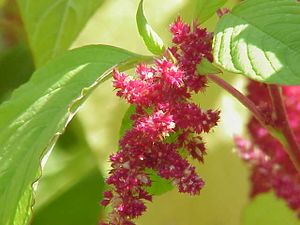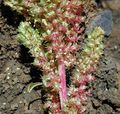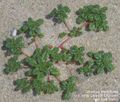القطيفة (نبات)
| Amaranthus | |
|---|---|

| |
| Amaranthus caudatus | |
| التصنيف العلمي | |
| مملكة: | |
| Division: | |
| Class: | |
| Order: | |
| Family: | |
| Subfamily: | |
| Genus: | Amaranthus |
| Species | |
| |
القطيفة الاسم الشائع لجنس من النباتات يضم أعشابًا وأزهار حدائق ومحاصيل. ,والقطيفة زينة تسمى طريحة الحب النازفة (فوق)، لها عناقيد من الأزهار القرمزية الطويلة المتدلية. ويتكون هذا الجنس بشكل رئيسي من الأعشاب، وتنمو نباتاته على نطاق واسع، خاصة في الأجواء الدافئة. وتحتفظ أزهار هذه النباتات بلونها حتى عندما تجفف.
وتعتبر نباتات قطيفة ذيل الثعلب قطيفة للزينة إذ تحتوي على مجموعة أوراق قرمزية طويلة متدلية. والقطيفة الأرجوانية نوع من النباتات الطويلة تحتوي على مجموعة ورود أرجوانية قرنفلية اللون يتأخر تفتحها قليلاً. ومن الأعشاب التي تنتمي لجنس القطيفة عشب الديسم العملاق ويسمى غالبًا الجذر الأحمر، وعشب الديسم المنتشر، ونوع من النباتات المتمايلة. وتدعى نباتات القطيفة التي تزرع من أجل بذورها الصالحة للأكل باسم قطيفة البذور. وكانت بذور القطيفة فيما مضى غذاء مهمًا لهنود الإنكا والأزتك.
التصنيف
الإستخدامات
حبوب قطيفة
الخضروات
Enama, M. (1994). "Culture: The missing nexus in ecological economics perspective". Ecological Economics. 10 (10): 93–95. doi:10.1016/0921-8009(94)00010-7.
Dyes
نباتات الزينة
القيمة الغذائية
الاعشاب
الاعشاب المفيدة
الأسطورة والشعر
Amaranth, or Amarant (from the Greek amarantos, unwithering), a name chiefly used in poetry, and applied to Amaranth and other plants which, from not soon fading, typified immortality.
Aesop's Fables (6th century BC) compares the Rose to the Amaranth to illustrate the difference in fleeting and everlasting beauty.
- A Rose and an Amaranth blossomed side by side in a garden,
- and the Amaranth said to her neighbour,
- "How I envy you your beauty and your sweet scent!
- No wonder you are such a universal favourite."
- But the Rose replied with a shade of sadness in her voice,
- "Ah, my dear friend, I bloom but for a time:
- my petals soon wither and fall, and then I die.
- But your flowers never fade, even if they are cut;
- for they are everlasting."
Or in story mode:
- An amaranth planted in a garden near a Rose-Tree, thus addressed it: "What a lovely flower is the Rose, a favorite alike with Gods and with men. I envy you your beauty and your perfume." The Rose replied, "I indeed, dear Amaranth, flourish but for a brief season! If no cruel hand pluck me from my stem, yet I must perish by an early doom. But thou art immortal and dost never fade, but bloomest for ever in renewed youth."
Thus, in John Milton's epic poem Paradise Lost (1667), iii. 353:
- "Immortal amarant, a flower which once
- In paradise, fast by the tree of life,
- Began to bloom; but soon for man's offence
- To heaven removed, where first it grew, there grows,
- And flowers aloft, shading the fount of life,
- And where the river of bliss through midst of heaven
- Rolls o'er elysian flowers her amber stream:
- With these that never fade the spirits elect
- Bind their resplendent locks."
Samuel Taylor Coleridge, in Work without Hope (1825), also refers to the herb, likely referencing Milton's earlier work. (ll 7-10 excerpted):
- Yet well I ken the banks where Amaranths blow,
- Have traced the fount whence streams of nectar flow.
- Bloom, O ye Amaranths! bloom for whom ye may,
- For me ye bloom not! Glide, rich streams, away!
Joachim du Bellay mentioned the herb in his "A Vow To Heavenly Venus," ca. 1500.
- We that with like hearts love, we lovers twain,
- New wedded in the village by thy fane,
- Lady of all chaste love, to thee it is
- We bring these amaranths, these white lilies,
- A sign, and sacrifice; may Love, we pray,
- Like amaranthine flowers, feel no decay;
- Like these cool lilies may our loves remain,
- Perfect and pure, and know not any stain;
- And be our hearts, from this thy holy hour,
- Bound each to each, like flower to wedded flower.
The "Amarantos" is the name of a several-century-old popular Greek folk song:
- Look at the amaranth:
- on tall mountains it grows,
- on the very stones and rocks
- and places inaccessible.
الموسيقى
- Enya refers to the everlasting amaranth in her song "Amarantine".
- Finnish metal band Nightwish features a song called "Amaranth" on their 2007 album Dark Passion Play, referring to the hidden amaranth.
- American metal band Virgin Steele has an instrumental song "Amaranth" on their 1998 album Invictus, referencing Greek mythology.
- AFI's song "The Great Disappointment" from their 2003 album Sing The Sorrow references the mythical Amaranth.
- Doom metal band Draconian also refers to the amaranth in their song "The Amaranth"
- The Issacs have a song titled Is not this the Land of Beulah which says, They are blooming by the fountain, ’Neath the amaranthine bow’rs.
- School of Seven Bells has a song entitled "Sempiternal/Amaranth" on their 2008 album Alpinisms.
- Opeth mentions the Amaranth Symbol in the song Black Rose Immortal "I have kept it the Amaranth Symbol Hidden inside the golden shrine"
- Bobo Dread Lutan Fyah sings about different vegetables and herbs and mentions "Callalloo for the blood" in the song "Natural Herbs" from the album "Healthy Lifestyle".
- American experimental band Kayo Dot personify Amaranth as a character in the song "Amaranth the Peddler" on their 2006 album Dowsing Anemone with Copper Tongue. The song also references Greek deities Mnemosyne and Morpheus.
- American indie rock band Of Montreal refers to a woman transforming into a black amaranth in their song "How Lester Lost His Wife" on their 2004 album Satanic Panic in the Attic.
في الثقافة الشعبية
انظر أيضاً
معرض الصور
Seabeach amaranth (A. pumilus), an amaranth on the Federal Threatened species List
ملاحظات
المصادر
- Lenz, Botanik der alt. Greich. und Rom. Botany of old. (1859)
- J. Murr, Die Pflanzenwelt in der griech. Mythol. Plants in Greek Mythology. (1890)
- المعرفية الشاملة
- [1]
وصلات خارجية
| Amaranthus
]].





